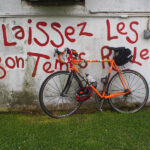For many dancers, the path to pursuing their passion can feel less like a smooth highway and more like the infamous Jersey Turnpike – long, congested, and often frustrating. Just like navigating the endless lanes and unexpected slowdowns of this notorious highway, dancers outside of major metropolitan hubs often face a challenging journey to access quality training, performance opportunities, and a thriving dance community.
This feeling of being stuck, of inching forward with limited visibility and constant obstacles, resonates deeply with the experiences of dancers in geographically isolated areas. Imagine the aspiration of a pirouette colliding with the reality of rush hour on I-95. This isn’t about the physical Jersey Turnpike, of course. It’s about the metaphorical one – the barriers that distance creates for dancers striving for a fulfilling career and artistic life.
The original article, “Out of Range,” poignantly describes this very struggle. The author recounts moving to rural Texas and encountering a dance desert, a stark contrast to the readily accessible arts scene of Massachusetts. The piece highlights the harsh realities of geographical limitations: vast distances, unreliable transportation, and a significant scarcity of resources. It’s a story that many dancers outside of major cities know all too well.
The Miles and Miles of Texas (and Dance Deserts Everywhere Else)
The author’s experience in Huntsville, Texas, is a powerful microcosm of a larger issue. The sheer size of Texas, where a four-hour drive simply leads to more Texas, underscores the problem of proximity. Unlike densely populated areas where dance studios, workshops, and performance venues are a short train or bus ride away, dancers in sprawling states or rural regions face logistical nightmares.
Transportation becomes a significant hurdle. As the article vividly illustrates with the unreliable bus and the sputtering Subaru, simply getting to a dance class can become an epic undertaking. The financial burden of gas, car repairs, and lost time quickly adds up, turning a passion into a costly and exhausting endeavor. This “transportation turnpike” is a major roadblock for aspiring dancers outside urban centers.
Beyond Transportation: The Resource Tollbooths
The challenges extend beyond mere transportation. Dance, like any art form, thrives on community and resources. Major cities act as vibrant hubs, attracting renowned instructors, companies, and funding opportunities. These urban centers are essentially dance “destinations,” easily accessible to those within their orbit.
However, for dancers outside these hubs, resources become scarce. Smaller towns often lack dedicated dance spaces, funding for arts programs, and a critical mass of fellow dancers to foster a supportive community. This “resource tollbooth” demands dancers pay a heavy price in terms of limited opportunities and artistic growth.
The Isolation Exit Ramp
Perhaps the most insidious aspect of this metaphorical Jersey Turnpike is the feeling of isolation. The article poignantly describes the author’s experience of dancing alone in her apartment, doom-scrolling through social media feeds filled with the successes of dancers in thriving scenes. This digital window into a vibrant world, juxtaposed with the stark reality of isolation, can be emotionally draining.
This isolation isn’t just about physical distance; it’s about a lack of connection, mentorship, and the vital exchange of ideas and inspiration that fuels artistic development. It’s like being stuck in your car, watching other dancers speed ahead in the fast lane while you’re caught in endless gridlock.
Finding On-Ramps and Building Bridges
While the “Jersey Turnpike of Dance Access” presents significant challenges, it’s not an insurmountable obstacle. The first step is recognizing and acknowledging these barriers. Openly discussing the geographical disparities in dance access is crucial to fostering a more equitable and inclusive dance world.
Just as road construction can improve highway flow, proactive measures can create “on-ramps” and “bridges” to connect dancers in underserved areas. These could include:
- Increased funding for regional arts programs: Directing resources to support dance initiatives in rural areas can help establish local studios, workshops, and performance opportunities.
- Mobile dance programs and residencies: Bringing dance education and professional artists to underserved communities can bridge the gap and provide valuable training and mentorship.
- Online platforms and virtual communities: Leveraging technology to create virtual dance communities can help connect isolated dancers, provide online classes, and foster a sense of belonging.
- Mentorship programs: Connecting dancers in rural areas with mentors in urban centers can offer guidance, support, and valuable industry connections.
Navigating the Dance Journey
The journey of a dancer is rarely a straight and smooth highway. For those navigating the metaphorical Jersey Turnpike of dance access, the road may be longer and more challenging. However, by acknowledging the obstacles, fostering community, and implementing creative solutions, we can work towards a dance world where geographical location doesn’t determine artistic destiny. Let’s strive to make the path to dance more accessible, ensuring that every aspiring dancer has the opportunity to reach their destination, regardless of where they start their journey.

